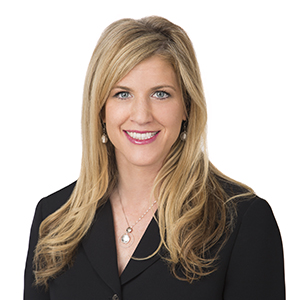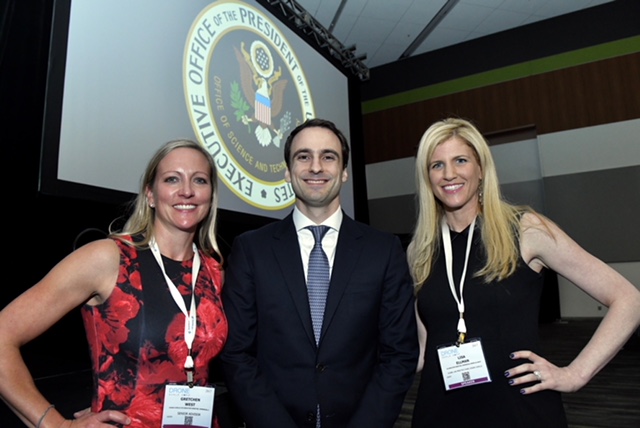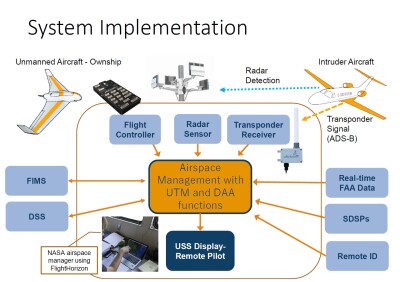To say that the Commercial Drone Alliance’s call for Congress to repeal Section 336 of the FAA Modernization and Reform Act of 2012 has been controversial is a bit of an understatement. Insight and analysis of their stance has come in from every angle, and there’s no shortage of opinions about this development. No matter your feelings on their position, what’s undeniable is that their effort to bring this issue to the forefront is helping to cement their roles as leaders in the space.

Lisa Ellman
The regulatory endeavors of the
Commercial Drone Alliance are led by Lisa Ellman, whose experience in government and industry have provided her with a unique perspective on these types of issues. She is a Partner at Hogan Lovells as well as Chair, Hogan Lovells' Global Unmanned Aircraft Systems Practice. She is also Co-Executive Director of the Commercial Drone Alliance and Co-founder of
Women of Commercial Drones. These roles have allowed her to provide commercial drone end users with unique and powerful representation in the space.
These advocacy efforts are pursued in tandem with efforts to educate on the benefits of drone technology for various end-user communities, and that sort of education is going to take center stage at the
Commercial UAV Expo. As the co-chair of an
advisory board that is a veritable who’s who in the drone industry, Ellman is working with organizations that range from Intel to AT&T to Facebook to BP to create a conference program showcasing what it means to utilize drones to perform a variety of tasks faster, cheaper and safer. We caught up with her to discuss how things are coming together for the event, but also detail the Alliance’s position on Section 336, what she tells end users who think the regulatory burdens associated with the technology are too high, and plenty more.
To read an interview with Co-Executive Director Gretchen West that is more focused on the business development efforts of the Alliance,
click here. Jeremiah Karpowicz: What can you tell us about your work at the White House and Department of Justice? What kind of experience did you gain from and in those roles? Lisa Ellman: When I was working on open government issues at the White House, we were focused on how to integrate emerging technologies into the federal government in ways that would open up the government to the American people. So I was working closely with the Digital Strategy team and focused on integrating emerging technologies into policy efforts. As the chief counselor for the Open Government Partnership, I was coordinating with other countries such as the United Kingdom and Brazil that were similarly committed to making progress on these issues. It was fascinating to learn about their systems and what they were doing, and to share best practices.
A lot of that experience drew from my time on the Obama campaign starting in 2007, when I ran our "My Policy" campaign that was designed to open up the policy-making of the campaign to the American people through technology. We used the Internet to actively reach out to people, and it was the first time a campaign had really used these tools to hear directly from the American people. Fast forward several years and my last appointment in the Administration was to run UAS policy development at the Department of Justice. My time spent focusing on emerging technology and policy really fueled a passion and interest in figuring out how to integrate the National Airspace System in a way that enables society to benefit from drone technology safely and securely.
Now that you’re on the other side of many of these conversations, do you find you approach individuals and issues in a different way than others who don’t have your perspective?My time in government has really helped inform me around how to be an effective advocate in the private sector, and also helped me to learn what is helpful to bring to these discussions. I know what information I needed in order to make a decision when I was in government, and it helped me to recognize the important role industry has in educating government officials around the issues that they're grappling with.
A lot of it comes back to education. For many in government, UAS is just one part of their portfolio. It's not what they do all day every day, so you need to educate them about the technology, about the use cases, about the potential and where the industry is going so that they're able to make good decisions. I think my time in government has helped me recognize what sorts of things they need to hear and see in order to make the critical decisions around UAS integration.
Do you think the FAA is struggling to deal with how to approach the regulation of drone technology because they’re doing so from the perspective of rules and laws that are based on manned aircraft? The FAA does an amazing job at regulating manned aviation, and its safety record is excellent -- that’s what the agency was designed to do. But as you suggest a 747 and the small drone you might use for a roof inspection are very different things, and so it’s clear that you can’t just take regulations for commercial aircraft and apply them to these small, very low weight drones without some absurd results in practice. That has been a challenge for this drone community, but we've seen a real shift in the FAA's mentality with the implementation of Part 107 in August 2016, for the first time ever broadly authorizing commercial drone operation.
The commercial drone industry is somewhat unique in that it wants to be regulated. Our industry wants to operate drones in ways that are safe and secure and respectful of the airspace, but the key is being able to do that in a way that makes sense. I think we've made progress, and Part 107 was an important step forward. Part 107 has opened up the industry in a way that is fantastic, but it's just the tip of the iceberg. We have a long way to go, because the rule only authorizes very low-risk operations. In order to take advantage of the safety and efficiency benefits of drones, we really need broadly expanded operations enabling companies to fly BVLOS, over people and at night without going through the special waiver and approval process.
And being able to open up the sky for expanded operations (flights over people, beyond visual line of sight, at night) that are broadly approved/allowed is at the core of your push to see Section 336 repealed, correct? Correct. It's interesting, because the commercial drone industry is somewhat of a new stakeholder in all of this. Hobbyists have been flying safely for decades. They have an excellent educational culture, and it's not that these hobbyists have done anything wrong. However, as technology has moved forward the national airspace system has changed and hobbyists are no longer flying alone. That's why we believe it is very important to have some basic “rules of the road” that apply to all operators. These rules should be cheap and easy to comply, but we need a guiding framework for the system.
We think it's critical that vehicles identify themselves, for example. Remote ID and tracking technology are out there, and in order for rules and laws to be enforced, we need to know who's flying in a licensed way. The Commercial Drone Alliance participated on the Remote ID rulemaking committee back in the fall, and one of the big questions that emerged was around threshold – or who Remote ID rules should cover. Should model aircraft be carved out of those rules?
The Alliance stood up and said that we believed all drones that weigh more than 250 grams should have some form of Remote ID, regardless of operator intent and in line with the existing registration threshold. We had many organizations agree with us on that, and some others disagree. It's been an ongoing debate that will continue, but we're engaging in ongoing conversations with other industry stakeholders, policymakers and lawmakers around what makes sense for the industry as we seek to open up the airspace for commercial drones over the next several years.
What can you tell us about these kinds of advocacy efforts in the context of the Alliance’s goal to create value for commercial enterprise end users that want to adopt drone technology?Our Alliance is focused on commercial drone end users and what they want to see and do with this technology. We represent commercial drone end users and the commercial drone segment of the broader drone ecosystem. Our focus is really on opening up the airspace to commercial drones and enabling broader expanded operations and doing so in a way that is safe and secure.
For example, we've been working closely with the federal government on drone security issues, and we recognize that the national security agencies have had some concerns about expanding drone operations. So we hosted two drone security summits last year that were off-the-record conversations between the commercial drone industry and policy-makers. These conversations helped move the ball forward in terms of engagement and mutual understanding. We're trying to educate officials around the potential for commercial drone technology and all the innovation that's out there. Much of our challenge is educating policymakers about existing technology which can solve some of the safety and security policy issues that exist.
I worked in the federal government, so I can tell you that government officials are very focused on what the policy issues are, but they're less aware of these technology solutions. That’s what we’re trying to bring to their attention. For example, geofencing technology can prevent drones from flying where they shouldn't be. Collision avoidance technology can prevent drones from crashing into other vehicles and structures. UTM will enable “highways in the sky.” These are just a couple of examples, but the point is that government ought to enable and incentivize technology that helps us to solve many of these policy issues.
That’s what the Commercial Drone Alliance seeks to do. We're trying to bring solutions and solve some of these problems so we can open up the airspace in a way that promotes innovation and wins the public’s trust. We try to bring awareness of the benefits of commercial drones and promote the interests of the community.
How has the lack of representation for commercial drone operators impacted regulation and even the position of commercial drone technology in the wider drone market as a whole?Because many of these applications are so new, policy makers are still getting to know the benefits of commercial drones, and the industry is getting to know those benefits as well. That's one of our challenges, because we're entering into an environment where other stakeholders – from the manned aviation and hobbyist communities, for example – have advocated their interests for a long time. We want to make sure our voice is heard and that we have a seat at the table, and I think you can see some of that with the push around Section 336
The “newness” of the industry led to a pretty challenging process to get commercial drones flying in the airspace. The Section 333 approval process was “one by one” and it wasn't until Part 107 that commercial drones were broadly authorized. But over the last few years we've made a lot of progress, and hopefully we'll continue to make that progress.
You’ve tied much of that progress to educating everyone about the benefits of drone technology, which is something you’ve also been doing in the context of the conference program for Drone World Expo and will now be doing at the Commercial UAV Expo. What can you tell us about industry events like these that are solely focused on the commercial application of drone technology? They're important. They bring a lot of amazing thinkers together in the same space and spark a ton of imaginative ideas, allow us to share best practices and talk about the challenges the industry is facing.
As one of the only B2B events that is focused on the commercial drone space, it's hugely helpful to spark new thoughts and to collectively share what are the challenges so that we can move everything forward. I'm looking forward to the show, because it’s going to have a great program with a lot of innovative entrepreneurs,
from both big companies and small. I think it's important to have a lot of different perspectives so that we can all learn from each other.
Do you think regulation will be a major topic of discussion at the event? Ever since Part 107, I’ve seen a big shift in focus and many end users are talking about data and logistics rather than regulation and approval. Or are operators and potential operators just as concerned about regulatory issues as they’ve always been?I think regulation is still top of mind for the companies that are looking to operate beyond Part 107.
For example, CNN is a company that has invested in their drone program and has really been committed to moving the policy boundaries forward, and there's a lot that companies can really learn from them. That’s why it’s essential to have them at the event and tell their story. They got the
precedent-setting Part 107 operations over people waiver, so I think they and many others are very focused on regulation simply because we still don't have broad authorization to fly beyond visual line of sight, over people, at night, and more.
That said, the kind of shift you mentioned is essential and something we’re seeing. It’s also indicative of the maturation of the technology. Now that companies are up and running and have a business, they can and are sorting through these challenges that are related to logistics and process. They’re issues that will certainly be addressed at the Expo.
What would you tell a potential commercial enterprise end user if they said they thought drones could help them, but they weren’t looking to move forward with adoption because of regulatory concerns and constraints?I would say there's a lot that can be done right now. It's always going to depend on the use case, but end users can do a lot right now that is perfectly legal under Part 107.
I would also say that if you think that drones are going to be helpful at all for your business at any time in the future, it's going to make sense to start exploring those possibilities today. It takes awhile to set up a process, train employees, devise your CONOPS, etc. It's always helpful to start thinking about and working through what that might look like now. Regulations are moving forward, and we expect to continue to see more progress over the next year or two. In the meantime, you might want to get everything you need in order to get up and running with the technology so that you know what's out there and you can fully leverage the technology when it makes sense for you to do so. It's not something that just happens overnight.
















Comments